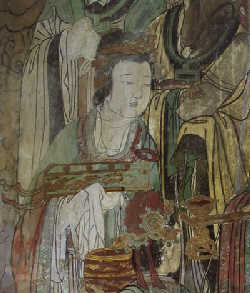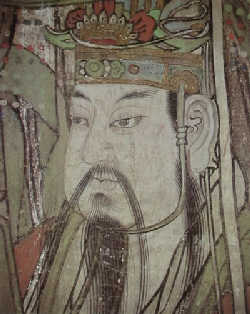The mural in the Sanqing Hall portrays Taoist scenes, with portraits of eight 3-meter-tall Taoist gods on the eastern, western and northern walls and on the two sides of the alcoves. Surrounding the gods are some 280 immortals who stand in long rows on four tiers; they include emperors, angels, deities, kings and immortal boys and girls. Some of them are talking, some listening, some looking around or pondering.

The figures portrayed in the Yongle Palace Mural represent fully the characteristics of traditional Chinese painting. The painters used simple, fluid and forceful strokes to depict the various expressions of living creatures of different ages and characteristics. The mural possesses a harmonious beauty with a strong decorative effect. The clothes of the major gods in the mural are painted bright red but the basic color of the mural is green with some use of golden powder, which imparts complete religious solemnity and tranquility. The 280 immortals in eight groups are drawn with varied expressions to avoid boredom and repetition.
The Yongle Palace Mural shares the painting style of the Chaoyuan Fairy Stick Painting by the famous Song Dynasty wall painter Wu Zongyuan. The portraits of figures are similar and they employ the same brushwork techniques. Their difference is that the Yongle Palace Mural depicts a moving immortal team, whereas Wu's painting presents a static worshiping scene.

Besides the Sanqing Hall, murals are also found in the Wuji Gate, the Chunyang Hall and the Chongyang Hall of the Yongle Palace. The mural in the Chunyang Hall was drawn 30 years later than those in the Sanqing Hall. It is a pictorial rendition of the life of Lu Dongbin in 52 consecutive scenes. At the background there are palaces, gardens, mountains, fields, streets and people from all walks of life. The mural in the Chongyang Hall tells the story of Wang Chongyang, initiator of the Quanzhen sect of Taoism. The painting style is similar to that of the Chunyang Hall with 49 consecutive scenes separated by mountains, stones, clouds and trees.
The murals in the Yongle Palace total 873 square meters. They have a rich content and are painted with refined skills. They are developed from the figure painting styles of the Tang and Song dynasties. Though the murals depict fairy stories, the figures in the paintings are realistic instead of abstract and have strong personalities. The painters, whose signatures appear on the murals -- Junxiang, Ma Qi and Zhang Junxiang --were ordinary folk artisan-painters with no personal records in art history, but their excellent art creations are forever recorded in Chinese painting history.
